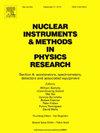Magnetic alignment methods for stretched wire systems in the measurement of insertion device magnetic field integrals at HEPS
IF 1.5
3区 物理与天体物理
Q3 INSTRUMENTS & INSTRUMENTATION
Nuclear Instruments & Methods in Physics Research Section A-accelerators Spectrometers Detectors and Associated Equipment
Pub Date : 2025-03-25
DOI:10.1016/j.nima.2025.170471
引用次数: 0
Abstract
The stretched wire system was widely employed in the development of insertion devices for HEPS, owing to its capability for rapid, high-precision, and efficient magnetic field integral measurements. However, the alignment accuracy of the wire remains a critical factor influencing the precision of these measurements. Traditional mechanical alignment methods are insufficient for high-precision requirements, as they cannot compensate for the inherent offset between the mechanical and magnetic centers. To address this limitation, this paper proposes two novel magnetic alignment methods based on theoretical analysis and experimental research. The first method was tailored for measuring single magnetic blocks. By evaluating the magnetic field integral with the block positioned in specific orientations, this method effectively eliminated measurement biases caused by angular deviations between the wire and the magnetic block, significantly improving measurement accuracy. The second method was designed for entire insertion devices. It introduced an innovative approach utilizing attached iron slices to generate a new reference signal, thereby reducing measurement biases between the Hall and stretched wire systems and enhancing the reliability of overall performance assessments. These magnetic alignment methods offered an efficient and innovative solution to improve the precision of magnetic field integral measurements at HEPS.
在HEPS测量插入装置磁场积分时拉伸导线系统的磁对准方法
拉伸线系统以其快速、高精度、高效的磁场积分测量能力被广泛应用于HEPS插入装置的开发中。然而,电线的对准精度仍然是影响这些测量精度的关键因素。传统的机械对中方法不能补偿机械中心和磁中心之间的固有偏移,不能满足高精度要求。针对这一局限性,本文在理论分析和实验研究的基础上,提出了两种新的磁对准方法。第一种方法是专门为测量单个磁块而设计的。该方法通过对定位在特定方位的磁块进行磁场积分,有效消除了磁线与磁块角度偏差造成的测量偏差,显著提高了测量精度。第二种方法是为整个插入装置设计的。它引入了一种创新的方法,利用附加的铁片来产生新的参考信号,从而减少了霍尔和拉伸线系统之间的测量偏差,提高了整体性能评估的可靠性。这些磁对准方法为提高HEPS的磁场积分测量精度提供了一种有效和创新的解决方案。
本文章由计算机程序翻译,如有差异,请以英文原文为准。
求助全文
约1分钟内获得全文
求助全文
来源期刊
CiteScore
3.20
自引率
21.40%
发文量
787
审稿时长
1 months
期刊介绍:
Section A of Nuclear Instruments and Methods in Physics Research publishes papers on design, manufacturing and performance of scientific instruments with an emphasis on large scale facilities. This includes the development of particle accelerators, ion sources, beam transport systems and target arrangements as well as the use of secondary phenomena such as synchrotron radiation and free electron lasers. It also includes all types of instrumentation for the detection and spectrometry of radiations from high energy processes and nuclear decays, as well as instrumentation for experiments at nuclear reactors. Specialized electronics for nuclear and other types of spectrometry as well as computerization of measurements and control systems in this area also find their place in the A section.
Theoretical as well as experimental papers are accepted.

 求助内容:
求助内容: 应助结果提醒方式:
应助结果提醒方式:


